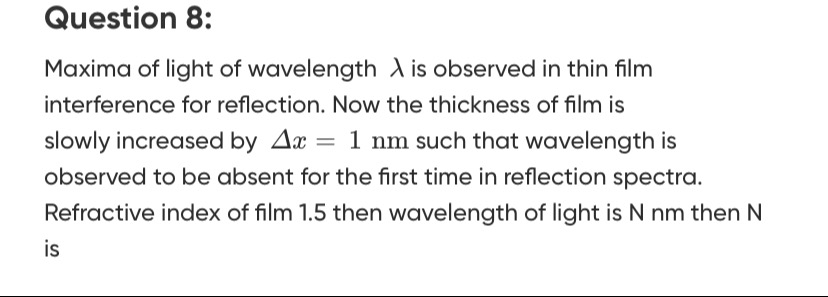Question
Question: Maxima of light of wavelength $\lambda$ is observed in thin film interference for reflection. Now th...
Maxima of light of wavelength λ is observed in thin film interference for reflection. Now the thickness of film is slowly increased by Δx=1 nm such that wavelength is observed to be absent for the first time in reflection spectra. Refractive index of film 1.5 then wavelength of light is N nm then N is

6
Solution
The condition for constructive interference (maxima) in reflected light from a thin film, considering a phase change of π at one interface, is given by: 2μtcosr=(m+1/2)λ where μ is the refractive index of the film, t is its thickness, r is the angle of refraction, λ is the wavelength of light, and m is an integer (m=0,1,2,...).
The condition for destructive interference (minima) is: 2μtcosr=m′λ where m′ is an integer (m′=1,2,3,...).
Assuming normal incidence, cosr=1. The equations become: Maxima: 2μt=(m+1/2)λ Minima: 2μt=m′λ
Let the initial thickness be t. A maximum is observed for wavelength λ. 2μt=(m+1/2)λ for some integer m≥0.
The thickness is increased by Δx=1 nm, so the new thickness is t′=t+Δx. For this new thickness, the wavelength λ is absent for the first time, meaning it corresponds to the first minimum encountered after the initial maximum. The sequence of conditions for 2μt/λ as thickness increases is: Maxima: 0.5,1.5,2.5,3.5,… (corresponding to m=0,1,2,3,…) Minima: 1,2,3,4,… (corresponding to m′=1,2,3,4,…)
If the initial maximum is of order m, the very next condition is a minimum of order m′=m+1. So, for the new thickness t′: 2μ(t+Δx)=(m+1)λ
Subtracting the initial condition from the new condition: 2μ(t+Δx)−2μt=(m+1)λ−(m+1/2)λ 2μΔx=(m+1−m−1/2)λ 2μΔx=(1−1/2)λ 2μΔx=21λ
We are given: Refractive index of film, μ=1.5 Increase in thickness, Δx=1 nm The original wavelength, λ=N nm
Substitute these values into the derived equation: 2×(1.5)×(1 nm)=21×(N nm) 3 nm=2N nm N=3×2 N=6
Thus, the wavelength of light is 6 nm.
